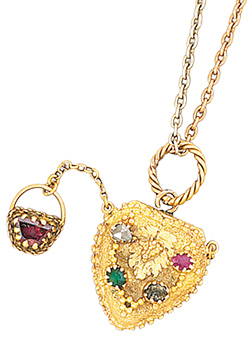|
Legacy
The Language of Jewels
Through the centuries, acrostic jewelry has used the language of gemstones to spell out sentiments of the heart.
By Phyllis Schiller
 |
| Late-nineteenth-century gem-set “Regard” necklace with heart-shaped locket with ruby, emerald and diamond details. Photo courtesy Christie’s Images Ltd. 2012. |
From words of love to celebrations of special occasions, acrostic jewelry added a special sparkle to rings, brooches and more with special coded messages “written” in gemstones. Like an acrostic puzzle, the first letter of each gemstone spelled out a word when taken in the order in which the gemstones were set, such as diamond, emerald, amethyst and ruby for “dear.”
The first use of acrostic jewelry is credited to a Parisian court jeweler named Jean-Baptiste Mellerio (1765-1850) during the early 1800s. Napoleon Bonaparte was said to be a fan of acrostic jewelry and commissioned several pieces to commemorate events for himself and family members, including acrostic bracelets for both his first wife, Josephine, and his second wife, Marie Louise.
The idea soon made its way across to England toward the end of the Georgian period, in the 1820s and 1830s, and eventually to the rest of Europe and America. It reached the height of popularity in England during the Victorian era (1837-1901). The Prince of Wales, the future Edward VII, gave his intended, Princess Alexandra of Denmark, a ring that spelled out his nickname, “Bertie.” Espousing a political cause, those opposed to the English Corn Laws wore “Repeal” jewelry, spelled out in ruby, emerald, pearl, emerald, amethyst and lapis lazuli.
The choice of materials ran the gamut from precious metals and jewels to base metals and paste stones. Which stone was chosen to represent a letter varied over time. For instance, vermeil, which today connotes gold-plated silver, previously was used to indicate garnet and so that gem represents the letter “v” in older pieces. Sometimes the color of the stone was used to signify a letter, such as fire opal for “f.”
Typically the acrostic message was a single word or short phrase adorning a ring, locket or pendant or bracelet, as well as the inside of a man’s watchcase or snuffbox. Sometimes the gems were arranged in a pattern, such as the petals of a flower, or centered around a larger stone. Popular words in English included “regards” and “dearest” and in French, souvenir (remember), amité (friendship) and “j’adore” (love).
While acrostic jewelry resonates especially with women over the age of 35, says Lisa Stockhammer-Mial, president of online retailer The Three Graces, she notes that the fact that the jewelry has meaning and is not just jewelry for jewelry sake broadens its appeal. “I think a certain segment of all ages gets tired of fads, trends and things with no substance. Those looking for more depth respond to the history and deeper purpose of this form of jewelry.”
Annette Brandt, A. Brandt & Son Antique Jewelry, Narbeth, Pennsylvania, points out that customers who are unfamiliar with antique acrostic jewelry initially appreciate the beauty of the designs. But, she says, “They are always delighted and fascinated to discover that the pieces also have hidden sentiments and are part of a historic tradition.” There’s a practical consideration as well. “The use of smaller gemstones in many acrostic pieces makes the price range affordable enough to attract women of a younger generation,” she explains.
According to Elizabeth Doyle, co-owner of Doyle & Doyle, a boutique in New York City, there is renewed interest in acrostics, especially among younger collectors. “Our younger clients are searching for pieces that tell a special story. Acrostics do just that, both with the message written in gems and the story of acrostics as a collectible category of jewelry.”
Judith Anderson, Bijoux Extraordinaire Ltd., The Jewelry Experts, Manchester, New Hampshire, who creates custom versions of jewelry with hidden messages for her clients, notes that this type of sentimental jewelry does appeal to today’s woman, whatever the age group. In terms of antique pieces, she says, “Brooches are the most popular style for acrostic messages.”
For Stockhammer-Mial, acrostic rings have reigned supreme in recent years. However, she points out that clients seeking Georgian examples also tend to seek out pendants “since they can be worn without too much undue wear and tear.” Doyle agrees that rings are “by far the most popular. Rings are often sentimental pieces; adding an acrostic message can make a special piece even more meaningful.”
Examples of acrostic jewelry from the nineteenth century or earlier are scarce, Stockhammer-Mial points out, and can reach higher figures. “As always, authenticity and condition, as well as overall beauty, play a large factor. Rings take the most wear over the decades, so these tend to be hard to come by in good condition.”
One of the difficulties in finding pieces in good condition with original stones, Doyle says, is that “much of the original acrostic jewelry was made in lightweight cannetille or stamped styles. They were easily damaged over the years and many of the softer stones became abraded and were replaced. We mostly see rings, although brooches can be found.”
Brandt notes that antique acrostic jewelry often brings a higher premium because they are favored among collectors. Certain words also seem to be especially popular, such as “adore,” “regard” and “dearest.” These words, she points out, can also describe any relationship held close to the heart, such as that of a mother and daughter, or two close friends. “Although jewelry styles change,” she sums up, “the sentiments communicated by acrostic jewelry are timeless. There is a certain sense of whimsy in wearing a piece of jewelry that carries a special message. This makes it universal enough to attract multiple generations.”Article from the Rapaport Magazine - April 2016. To subscribe click here.
|
|